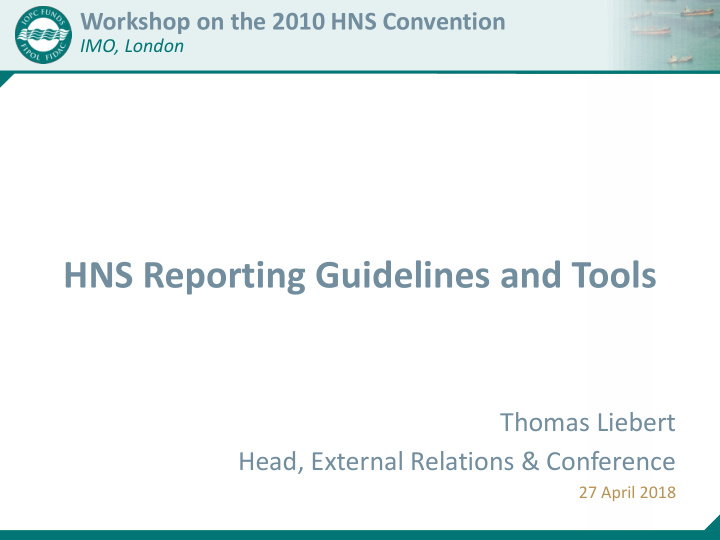



Workshop on the 2010 HNS Convention IMO, London HNS Reporting Guidelines and Tools Thomas Liebert Head, External Relations & Conference 27 April 2018
HNS Fund Four separate accounts There is one general account (bulk solid sector and other HNS sector) and three separate accounts in the General HNS Fund. Account Each account will meet the cost of HNS compensation payments (no cross- Oil LPG Fund Account Account subsidization). Each account activated when the LNG total quantity of contributing cargo Account reaches the required threshold.
HNS Fund Thresholds for each account Threshold for Establishment Threshold for of account contribution General Account 40 million tonnes* • Bulk solids 20 000 tonnes • Other HNS Oil Account 350 million tonnes • Persistent oil 150 000 tonnes • Non-persistent oil 20 000 tonnes LPG Account 15 million tonnes 20 000 tonnes LNG Account 20 million tonnes No minimum *Condition for entry into force
Reporting obligations Obligation of Member States Before entry into force • Member States need to submit a report on total contributing cargo received when depositing ratification or accession instrument to IMO • Have to continue to report every year thereafter until entry into force
Reporting to HNS Fund What is contributing cargo? Article 1.10 of the HNS Convention Any bulk HNS which is carried by sea as cargo to a port or terminal in the territory of a State Party and discharged in that State ✓ Packaged HNS is not considered contributing cargo ✓ Transit cargo is not considered contributing cargo
HNS Finder For more information: www.hnsconvention.org
Reporting to HNS Fund Who is the receiver? Each person who has physically received contributing cargo after sea transport in a Member State, in a calendar year, in quantities above the threshold specified in the Convention, but: • A person who physically receives HNS on behalf of a third party may designate that third party as the receiver (Agent / Principal concept) • For LNG, annual contribution shall be made by the receiver or by the titleholder, if it has agreed to it • Member States may establish their own definition of ‘receiver’ , for as long as the quantity of contributing cargo remains the same as per the HNS Convention definition
HNS Contributing Cargo Reporting Guidelines Main features Issues to consider Before the Protocol enters into force 1. Definition of contributing cargo Article 1.10 “any bulk HNS which is carried by sea as cargo to a port or terminal in the territory of a State Party and discharged in that State” 2. Definition of receiver Article 1.4 (a) “the person who physically receives contributing cargo discharged in the ports and terminals of a State Party” • 3. Relationship between the receiver and the Submit contributing cargo reports only • principal Provide info on principal receivers • 4. Relationship between the receiver of LNG Submit contributing cargo reports only • and the titleholder Provide info on titleholders
HNS Contributing Cargo Reporting Guidelines Main features Issues to consider Before the Protocol enters into force 5. Definition of transhipment Use ship-to-ship transfer operations as a reference from the 1992 Fund reporting guidelines 6. Threshold limits for reporting Lower thresholds to facilitate the ID of potential receivers 7. List of contributors and criteria for Physical receivers are liable to provide identification contributing cargo reports • Principals likely to be in non-Member States • Limiting reporting obligations useful for monitoring • Physical receivers to also identify contributors
HNS Contributing Cargo Reporting Guidelines Main features Issues to consider Before the Protocol enters into force • 8. Contributing cargo reporting forms Physical receivers to Government authority • Government to IMO • Nil declarations • 9. Submission of reports At the time of ratification • Each year thereafter 10. Compliance and verification The guidelines to be adopted prior to ratification/accession to facilitate reporting
HNS Contributing Cargo Reporting Before entry into force 12 States need to ratify 31 October 2012 Entry into force (8 States signed) (+ 18 months) Physical Receiver has reporting obligation States to Identify potential contributors Terminal Storage To facilitate, lower threshold limits for reporting
Reporting and financial obligation After entry into force Entry into force 4 scenarios Principal Receiver Physical Receiver (when not agent) Transhipment Receiver in different Titleholder country (for LNG) HNS Fund Assembly • To adopt internal regulations to address those scenarios • To decide on final reporting and contribution procedures
www.hnsconvention.org
Recommend
More recommend